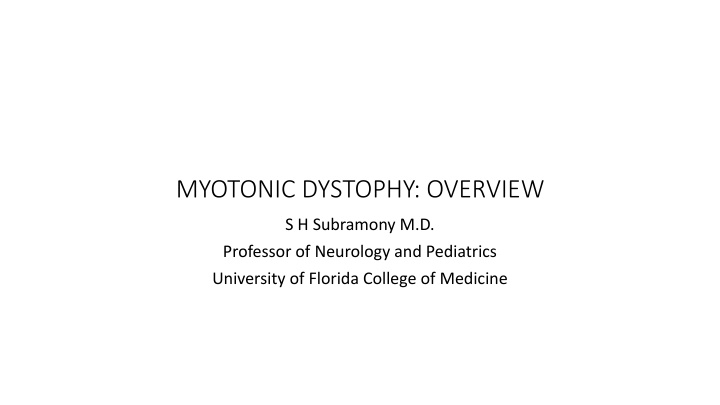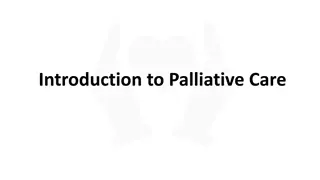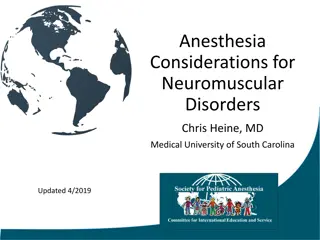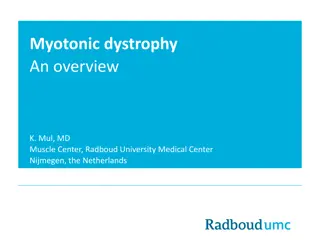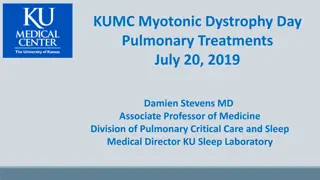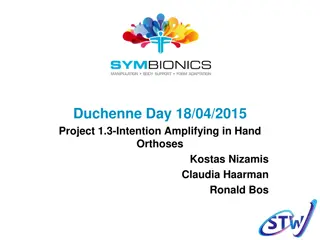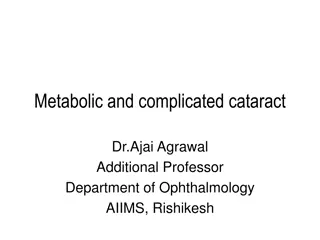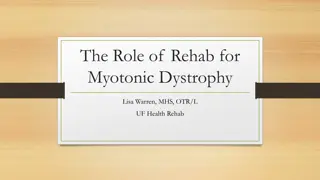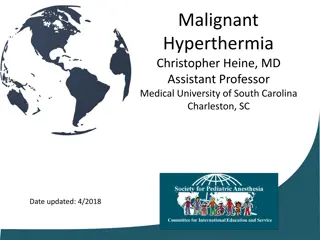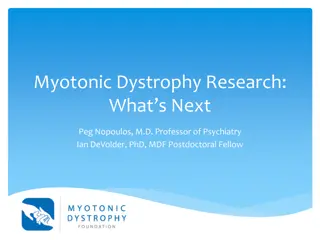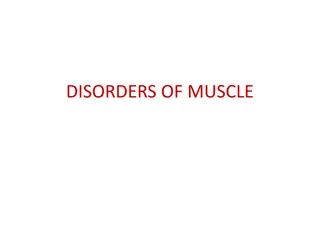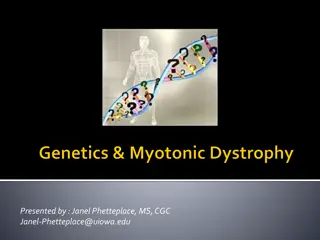Myotonic Dystrophy: Overview and Care Essentials
Myotonic dystrophy is a neuromuscular disorder characterized by various symptoms affecting patients' daily lives. Understanding the diagnosis, challenges, and care requirements for patients and their families is crucial. This overview covers key findings, symptoms, and important considerations for managing myotonic dystrophy effectively.
Download Presentation

Please find below an Image/Link to download the presentation.
The content on the website is provided AS IS for your information and personal use only. It may not be sold, licensed, or shared on other websites without obtaining consent from the author.If you encounter any issues during the download, it is possible that the publisher has removed the file from their server.
You are allowed to download the files provided on this website for personal or commercial use, subject to the condition that they are used lawfully. All files are the property of their respective owners.
The content on the website is provided AS IS for your information and personal use only. It may not be sold, licensed, or shared on other websites without obtaining consent from the author.
E N D
Presentation Transcript
MYOTONIC DYSTOPHY: OVERVIEW S H Subramony M.D. Professor of Neurology and Pediatrics University of Florida College of Medicine
Steinert H (1909) ber das klinische und anatomische Bild des Muskelschwunds der Myotoniker. Dtsch Z Nervenheilkd 37:58 104 Claude Monet's vision. Lane R, Carey N, Orrell R, Moxley RT 3rd. Lancet. 1997 Batten, Gibb 1910 Myotonic dystrophy in Ancient Egypt. Cattaino G, Vicario L. Eur Neurol. 1999
CHRISTOPHER PROJECT Survey of >1000 North American patients and > 400 caregivers Queries designed by expert consensus Findings Age at diagnosis: 31 15 for DM 1 and 44 17 for DM2 Diagnostic delay; 5.7 7.1 for DM1 and 7.9 9.4 for DM 2 Bachelor degree: 45 and 46% DM 1 and DM 2 ( US population 35%) Fully employed: 17 and 22% for DM 1 and DM 2 (US population >60%) Unable to work: 46% for both DM 1 and DM 2 Income >40,000: 17 and 29% for DM 1 and DM 2 (30% US households) >20% felt no assistance after diagnosis Lack of resources and emotional impact most challenging aspects
Concentration problems, sleep problems, learning: alertness, planning activities Heart rhythm, shortness of breath, fainting Baldness, fertility problems, diabetes Swallowing, constipation, pain, diarrhea Shortness of breath, infections Weakness, aches, droopy lids, myotonia: mobility, driving, ADL DM 2: similar problems but all less frequent and less severe Congenital myotonic dystrophy
CARING FOR MYOTONIC DYSTROPHY PATIENTS AND FAMILIES Life threatening issues Anticipation and prevention. Importance of communication between experts, families and primary care Cardiac disease (prevent rhythm problems) Neuromuscular respiratory compromise (prevent infections, prevent low oxygen and high carbon dioxide levels) Anesthetic issues (communication between experts; muscle, heart, breathing, stomach and brain dysfunctions all contribute to potential for complications) Anesthesia stand-by Gastric pseudo-obstruction Medications to avoid? Statins, other neurotoxins and myotoxins
CARING FOR MYOTONIC DYSTROPHY PATIENTS AND FAMILIES Many issues can be managed effectively Heart: W.Miles Respiration: B.Smith Swallowing: E.Plowman Motor rehab: D.Lott Pregnancy and genetics: D.Barbouth More difficult issues Cognition: J. Williamson Educational access/ social issues: E Conte and B Roland GI issues
Lancet Neurol. 2018 Aug;17(8):671-680. Cognitive Cognitive behavioural behavioural therapy with optional graded exercise therapy in patients with severe therapy with optional graded exercise therapy in patients with severe fatigue with myotonic dystrophy type 1: a fatigue with myotonic dystrophy type 1: a multicentre multicentre, single Okkersen K1, Jimenez-Moreno C2, Wenninger S3, Daidj F4, Glennon J5, Cumming S6, Littleford R7, Monckton DG6, Lochm ller H8, Catt M9, Faber CG10, Hapca A7, Donnan PT7, Gorman G11, Bassez G4, Schoser B3, Knoop H12, Treweek S13, van Engelen BGM14; OPTIMISTIC consortium. , single- -blind, blind, randomised randomised trial. trial. All patients started with psycho-education and goal formulation. Patients were then offered a tailored CBT intervention consisting of a maximum of six modules: 1) Learning to compensate for a reduced initiative; 2) Optimize social interactions with caregivers;3) Regulation of sleep- wake pattern; 4) Reformulation of dysfunctional beliefs with respect to fatigue or DM1; 5) Activity regulation and graded activity; 6) Coping with pain Improved DM Activ score Improved 6 MWT Improved accelerometry Improved fatigue score
CARING FOR MYOTONIC DYSTROPHY PATIENTS AND FAMILIES Novel, disease altering therapies being rapidly developed Participating in clinical research May include both treatment trials and non-intervention studies such as natural history, COA and biomarker studies Varying length and visit schedules Varying inclusion and exclusion criteria Travel costs, payment to participate, drug costs Time between participation and result availability Risks of intervention, procedures, confidentiality issues Genetic tests
ONGOING CLINICAL RESEARCH STUDIES AT UF END-DM1 Myotonic Dystrophy Brain imaging and Social Cognition in myotonic dystrophy Studies of skeletal muscle and gastrointestinal dysfunction in myotonic dystrophy and controls CNG Biobank Contacts S H Subramony M.D., Stephen Gullett, Victoria Hope, Amanda Cowsert 352 273 5550
